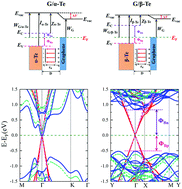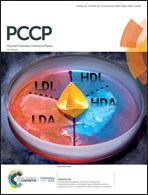Tunable Schottky and Ohmic contacts in graphene and tellurene van der Waals heterostructures†
Abstract
We systematically investigate the effects of external electric field and interlayer coupling on the electronic structures and contact characteristics of hybrid graphene and tellurene (G/Te) van der Waals heterostructures (vdWHs) based on first-principles calculations. Our results show that the G/α-Te interface is formed by an n-type Schottky contact with a negligible Schottky barrier height (SBH), while the G/β-Te interface is formed by a p-type Schottky contact with a SBH of 0.51 eV. By applying external electric fields perpendicular to the G/Te interfaces or changing the interlayer distance between the graphene and tellurene monolayers, both Schottky barriers and contact types (n-type Schottky, p-type Schottky, and Ohmic) at the G/Te interfaces can be effectively modulated. The changes in charge transfer, as well as the corresponding interface dipole and potential step with the external electric field and interlayer coupling, are revealed to account for the reason for tunable Schottky and Ohmic contacts at the G/Te interfaces. Therefore, the G/Te vdWHs show tunable Schottky and Ohmic contacts with promising applications of graphene-based field-effect transistors in future experiments.



 Please wait while we load your content...
Please wait while we load your content...